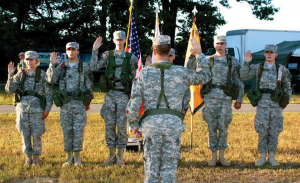
COURTESY ROTC
Cadets in the Hoya Batallion — who are drawn from five different schools in the D.C. area — participate in IX Field Training as part of the Reserve Officers Training Corps program.
It’s a surprise that so few students know about the Georgetown Reserve Officer Training Corps, an organization that can trace its roots back to the founding of Georgetown and has impressed the likes of George Washington and Andrew Jackson. Ranked first in the nation, the ROTC program has been a part of campus culture since the university’s early days and is an integral part of the Hilltop experience for the approximately 30 students who take part in it.
The Georgetown ROTC program is part of the Hoya Battalion, which is comprised of students from five different academic institutions: American University, Catholic University, The George Washington University, the Institute for World Politics and Georgetown. In total, the battalion consists of around 125 cadets, approximately one-fourth of whom attend Georgetown. The goal of the program is to prepare young men and women in college to be officers in the U.S. Army.
The Battalion is unmistakably good at producing talented officers. It was ranked the number one senior battalion in the country out of a total of 272 programs. In fact, former Army Chief of Staff George Casey (SFS ’70) graduated from Georgetown’s program.
Although the program can trace its origins to the inception of Georgetown — the first Georgetown student was also the first Georgetown College cadet — it didn’t officially start until the 1830s. The program has been active since then, commissioning more than 4,100 officers and participating in every major military conflict. For the Hoya Battalion, this rich history is a point of pride.
The battalion’s past would not be as impressive without the day-to-day hard work demanded of the cadets. Georgetown ROTC members attend a special three-hour class once a week and have physical training early in the morning three times a week, along with a number of other activities. They also spend eight total days in the field doing training exercises throughout the year. For Cadet Sergeant Jake Green (SFS ’15), his commitment is a couple of hours per day. Cadet Major and Battalion Executive officer Ryan Gildersleeve (SFS ’14) clocks in 30 to 40 hours on a slow week and 50 to 60 hours in the ROTC office during a busy week.
In addition, after a cadet’s junior year, there is a mandatory month-long training program. Some cadets elect to do programs like Air Assault School or Army Airborne School during the summer.
With such a busy schedule, it’s hard to imagine how these cadets are able to balance academics, ROTC and their other activities, because being a cadet in ROTC at Georgetown does not exclude the participants from being involved in other extracurriculars. “We’re pretty fun people. We do our ROTC thing and we love that, but we also love other things,” Cadet Private First Class Brenna Muldrow (MSB’16) said. Muldrow is also an MSB peer ambassador and works three part-time jobs. (Muldrow also works in The Hoya’s corporate development department.)
Even senior officers balance the time they spend with ROTC with other campus activities.Gildersleeve participated in the now-disbanded mixed martial arts group and coordinated Georgetown Opportunities for Leadership Development last year.
With his new upper-level role, however, Gildersleeve can no longer engage in these activities because of his increased time commitment to ROTC.
In the past few years, ROTC members have petitioned the university to expand the same registration privileges given to varsity athletes to cadets in order to help accommodate their busy schedules. Members have argued that their time commitments are similar to that of a varsity athlete, and they therefore deserve the same treatment.
With the intense time commitment, one could see why it might be hard for cadets to feel at home at Georgetown. Their offices were pushed off-campus due to a divide between the university and the program that emerged during Vietnam War protests and pressures. Although tensions between the university and the program have since dissipated, members do not feel completely immersed in campus culture.
Socially, however, the cadets don’t have too hard of a time integrating into the Georgetown community. Although they build strong bonds with their fellow ROTC cadets, they have diverse friend groups.
“I’ve made some of the best friends of my life outside of ROTC here,” Green said.
There’s also a general ignorance among the Georgetown community about ROTC. “A lot of people consider anybody in the military to be extremely conservative and all these other things. You’ll find that a lot of the cadets come from very different backgrounds, be it politically or socially,” Gildersleeve said.
Another common misconception is what happens to cadets upon graduation. Juniors in the program must commit to eight years of total service. Muldrow would like to make a career out of her military service by serving twenty years, but others, like Green, just plan on seeing where the army takes them.
Even if it doesn’t end up shaping their careers, ROTC defines students’ lives on campus.








